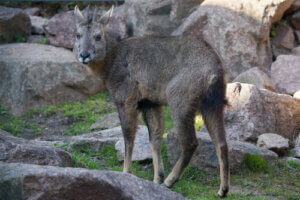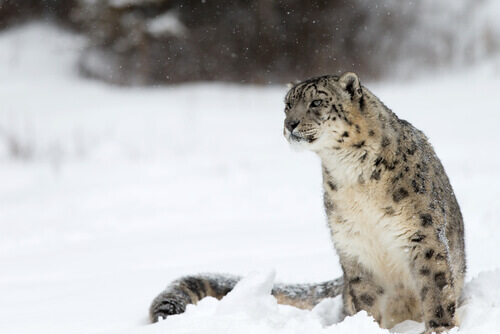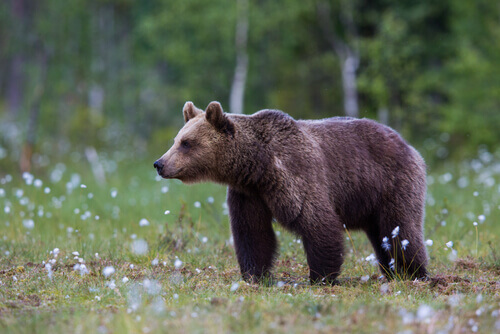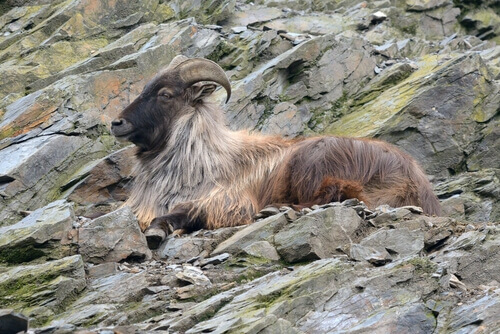The Fauna of the Himalayan Mountains

The Himalayan mountains, or the Himalayas, are the highest mountain range in the world and, although its climate is so adverse, many species have adapted in order to live there. In this article, we’ll tell you what animals belong to the Himalayan fauna. Believe it or not, this area is home to almost 400 wild species!
What is the fauna of the Himalayan mountains like?
Most of the inhabitants here are birds, although mammals are the most famous. The best time to see the Himalayan wildlife live is in autumn, from September to November, when the animals migrate to lower altitudes. Some of the most characteristic ones are:
1. The goral
This bovid is present throughout the Himalayan mountain range and its population is declining due to hunting. It lives in areas up to 4,000 meters (13,000 feet) above sea level and males occupy marked territories of about 62 acres. It’s very agile, runs at high speed, and feeds on grasses and leaves.
The goral, which appears in this article’s main image, measures about 51 inches and weighs about 88 pounds. It has gray or brown fur, brown legs, and a dark stripe on the spine. Both females and males have backward-curved horns that are almost 8 inches long.
2. The snow leopard
This carnivorous mammal lives throughout the mountains of Central Asia at altitudes of up to 6,000 meters (20,000 feet) and not much is known about it. Its main characteristic is its thick, dense, spotted gray fur; it has a large tail that serves as a coat when it sleeps.

3. The yak
This bovid is another typical representative of the fauna of the Himalayan mountains. It lives in the steppes and cold deserts located between 13,000 and 20,000 feet above sea level, either wild or domesticated. The word ‘yak’ in Tibetan means ‘male’, so females are known as ‘nak’.

4. The Himalayan brown bear
Its scientific name is Ursus arctos isabellinus, in honor of Queen Elizabeth, and it inhabits both the slopes of the Himalayas and the Karakorum. Since it’s very difficult to spot them, experts are unaware of many specimens inhabit the region.

The Himalayan brown bear shows great sexual dimorphism, with males reaching 87 inches in height and females 71 inches. Both sexes hibernate from October to April in a den or cave. They feed on plants, roots, insects, and small mammals, which they hunt after sunset.
5. The tahr
The Himalayan fauna is composed of several goats, such as the tahr, which can be seen between India and Tibet. It can measure about 5.5 feet and weigh around 400 lb; it has short horns curved backward, and the males have a kind of mane that shelters them in the harsh winter.

The Himalayan mountains, or the Himalayas, are the highest mountain range in the world and, although its climate is so adverse, many species have adapted in order to live there. In this article, we’ll tell you what animals belong to the Himalayan fauna. Believe it or not, this area is home to almost 400 wild species!
What is the fauna of the Himalayan mountains like?
Most of the inhabitants here are birds, although mammals are the most famous. The best time to see the Himalayan wildlife live is in autumn, from September to November, when the animals migrate to lower altitudes. Some of the most characteristic ones are:
1. The goral
This bovid is present throughout the Himalayan mountain range and its population is declining due to hunting. It lives in areas up to 4,000 meters (13,000 feet) above sea level and males occupy marked territories of about 62 acres. It’s very agile, runs at high speed, and feeds on grasses and leaves.
The goral, which appears in this article’s main image, measures about 51 inches and weighs about 88 pounds. It has gray or brown fur, brown legs, and a dark stripe on the spine. Both females and males have backward-curved horns that are almost 8 inches long.
2. The snow leopard
This carnivorous mammal lives throughout the mountains of Central Asia at altitudes of up to 6,000 meters (20,000 feet) and not much is known about it. Its main characteristic is its thick, dense, spotted gray fur; it has a large tail that serves as a coat when it sleeps.

3. The yak
This bovid is another typical representative of the fauna of the Himalayan mountains. It lives in the steppes and cold deserts located between 13,000 and 20,000 feet above sea level, either wild or domesticated. The word ‘yak’ in Tibetan means ‘male’, so females are known as ‘nak’.

4. The Himalayan brown bear
Its scientific name is Ursus arctos isabellinus, in honor of Queen Elizabeth, and it inhabits both the slopes of the Himalayas and the Karakorum. Since it’s very difficult to spot them, experts are unaware of many specimens inhabit the region.

The Himalayan brown bear shows great sexual dimorphism, with males reaching 87 inches in height and females 71 inches. Both sexes hibernate from October to April in a den or cave. They feed on plants, roots, insects, and small mammals, which they hunt after sunset.
5. The tahr
The Himalayan fauna is composed of several goats, such as the tahr, which can be seen between India and Tibet. It can measure about 5.5 feet and weigh around 400 lb; it has short horns curved backward, and the males have a kind of mane that shelters them in the harsh winter.

This text is provided for informational purposes only and does not replace consultation with a professional. If in doubt, consult your specialist.








